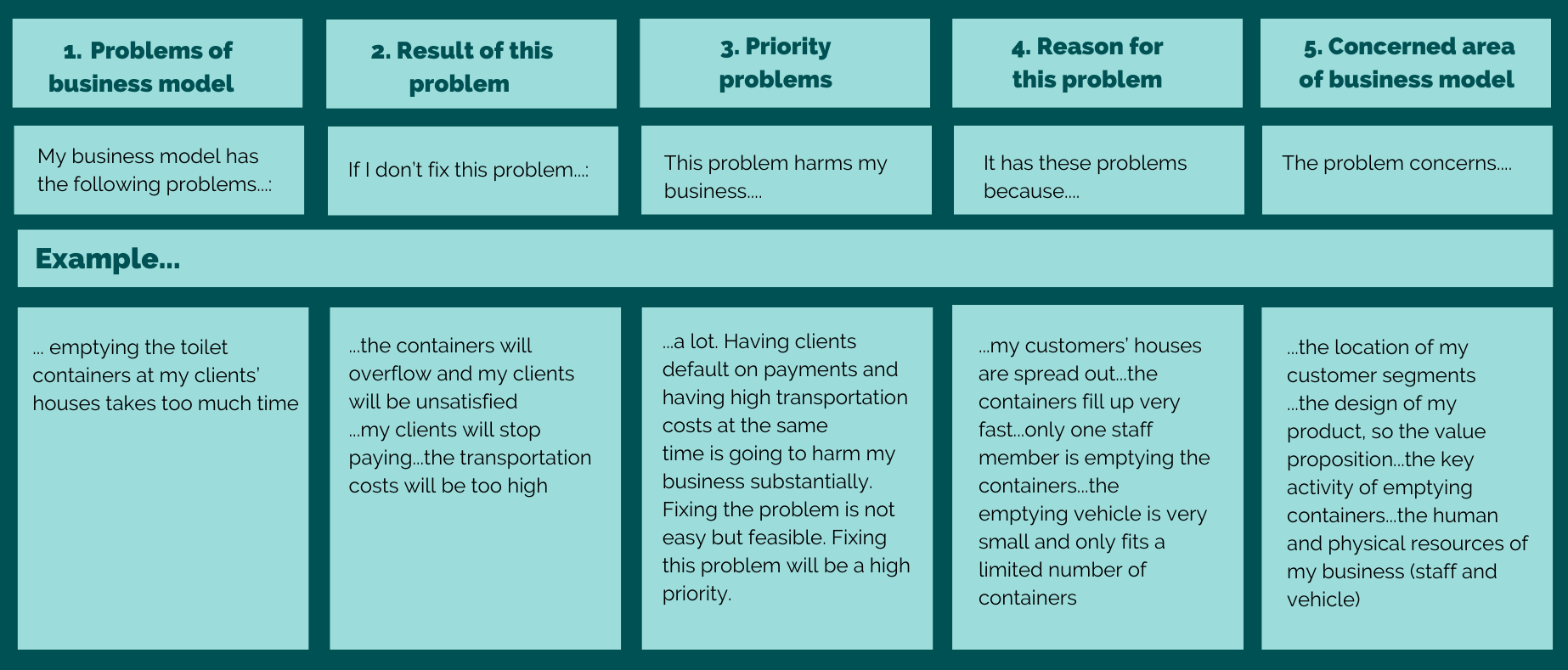Executive Summary
You have spent time to develop a water-related business model and might have even started rolling it out already. However, you might be facing specific challenges such as: struggling to make your business model feasible, struggling to enter the market successfully or to adapt your offers to customer needs, etc. If you haven’t already, you should also ask yourself the following question: Does your business model adequately respond to the opportunities and threats that the market, the competition, the political framework, advances in technology and so on present to you?
This factsheet will help you to analyse the strengths and weaknesses as well as opportunities and threats (SWOT) of your business model in order to effectively identify entry points to innovate it. While you may have probably already used the business model canvas to depict your vision and plan, you can also use it as an analytical tool for identifying your innovation challenge – both before you venture into your business and while you are already operating. Remember that innovating business models is a dynamic process that needs to be continuously repeated to adapt to changing customer needs and the dynamics of your business environment.
How to focus your analysis
Analysing your business model to detect innovation challenges can be a daunting task and you might not know where to begin. Instead of starting with the long list of questions below, you might want to first focus your analysis on a specific area of the business model. If you have done the analysis of your business idea already with the help of the previous factsheet “Empathise and analyse your business idea“, you probably already have a general idea of whether your innovation challenge has to do with the positioning of your business, i.e. customer segments, value proposition, customer relationships, channels, revenue streams or social and environmental benefits, or whether it has to do with the operations of your business, i.e. key activities, key resources, key partnerships, cost structure or social and environmental costs of your business.
To further narrow down your analysis, have a look at the table below and ask yourself the following questions:
- What are the most obvious problems of my business model? Think off the top of your head and ask experts for their feedback.
- What would happen to my business if I didn’t fix this problem?
- Which of the problems should I address first? Think of the harm this problem could cause to your business and how easily it can be fixed.
- What caused this problem and why is it there?
- Which area of the business model does this problem concern?
Following the example in the table below, record your answers in this worksheet!

In the example presented above the identified problem has multiple causes. Emptying the containers takes too much time because the customers are geographically spread out, the containers that have been designed are small and fill up fast, the business vehicle can only carry 20 containers at a time, meaning that the staff member responsible for emptying containers has to go back and forth several times a day to empty all containers. If this problem wasn’t fixed, containers would overflow and the unsatisfied customers would stop paying their bills. This and the costs associated with the vehicle going back and forth would have a severe effect on the finances of the business. The problem should thus be addressed as a high priority. To tackle this problem, the focus of the analysis needs to be on these areas of the business model and their corresponding questions: customer segments, value proposition, key activities and key resources.
Comprehensive questions for analysing your business model
To be able to pinpoint your innovation challenge, here is a (non-exhaustive) list of analytical questions (derived from OSTERWALDER and PIGNEUR 2010) that you should reflect on in order to determine exactly what areas of your business model need adaptations and where you should focus your innovation process. It is important to keep in mind at this point that not all adaptations to your business model will necessarily need an innovation. Sometimes it is sufficient to adapt well-established industry standards to make the business model work.
Go through the following questions according to the different areas of the business model canvas and try to assess your business model and its strengths and weaknesses, as well as detecting threats and opportunities you might need to respond to. You may focus on priority areas that you have identified in the table above. Record your answers in this worksheet.
When going through the worksheet, it is important to not just rate your business model but also justify your answer by explaining how the statements are true or not true. Also, clarify if your answer is simply an assumption or whether it is actually backed by evidence from research or a field test with real customers for instance. Be critical with yourself and provide honest answers. It is totally ok to leave blank spaces or provide assumptions for now! You will get the chance to validate them when you prototype your business later on. The most important thing at this stage is to get started with the analysis.
Customer Segments
- How well is your customer base segmented?
- How easily do you acquire new customers?
- How big are your customer segments?
- How likely are your customers to defect on payments?
- Is competition likely to threaten your market share?
- Could you benefit from a growing market?
- Could you serve new Customer Segments?
- Could you better serve your customers through finer segmentation?
Value Propositions
- How well is your value proposition aligned with your customer needs?
- How unique is your value proposition?
- Are customers currently using substitute products or services or competing solutions?
- How strong are the synergies between your products and your services?
- How strong are the synergies between your value proposition and the rest of your business model?
- Are competitors threatening to offer better price or value?
- Could you generate recurring revenues by converting products into services?
- Could you better integrate your products or services?
- Could you satisfy additional customer needs?
- Are complements to or extensions of your Value Proposition possible?
- Could you do other jobs on behalf of customers?
Revenue Streams
- Do you manage to undercut your competitors’ prices?
- How strong are your margins?
- Are competitors threatening your margins?
- How predictable are your revenues?
- How frequent do your customers purchase your products/ services?
- How diversified are your revenue streams?
- How likely are your revenue streams to disappear in the future?
- How sustainable are your revenue streams?
- Do you collect revenues before you incur expenses?
- Do your payment methods reflect your customers’ requirements?
- How unique are your payment methods?
- Do you charge for what customers are really willing to pay for?
- Do you charge for what customers are really able to pay for?
- Are your margins likely threatened by competitors? By technology?
- Do you depend excessively on one or more Revenue Streams?
- Are some Revenue Streams likely to disappear or decrease in the future?
- Can you replace one-time transaction revenues with repeated revenues?
- Would your customers be willing to pay for other elements?
- Do you have cross-selling opportunities either internally or with partners?
- Could you add or create other Revenue Streams?
- Could you increase prices?
Channels
- How effective are your channels in reaching your customers?
- How visible are your channels for your customers?
- How well are your channels adapted to your customers’ routines?
- How efficient are your channels?
- How well are your channels integrated to cover the whole customer experience?
- How unique are your channels?
- Are competitors threatening your channels?
- Are channels in danger of becoming irrelevant for customers?
- Could you improve channel efficiency or effectiveness?
- Could you integrate your Channels better?
- Could you find new complementary partner Channels?
- Could you increase margins by directly serving customers?
- Could you better align Channels with Customer Segments and their routines?
Customer Relationships
- How well do your customer relationships reflect what customers expect from you?
- How well do your customer relationships bind your customers to avoid them switching to alternative products/ services?
- How strong is your brand?
- How unique are your customer relationships?
- Are your customer relationships in danger of deteriorating?
- Is there potential to improve customer follow-up?
- How could you tighten your relationships with customers?
- Could you improve personalisation?
- How could you increase switching costs to avoid customers switching to alternative products/ services?
- Have you identified and “fired” unprofitable customers? If not, why not?
- Do you need to automate some relationships?
Social and Environmental Benefits
- How well does your business generate positive social benefits?
- How well does your business generate positive environmental benefits?
- Do the social and environmental benefits your business generates reflect industry standards?
Key Activities
- How efficiently do you carry out your key activities?
- How easy is it to copy your key activities?
- How high is the quality of your activities?
- How balanced is the share of in-house versus outsourced activities?
- How likely can key activities be disrupted by external events?
- How likely is the quality of key activities threatened by external events?
- Could you standardise some Key Activities?
- Could you improve efficiency in general?
- Could any type of technology boost efficiency?
Key Resources
- How easy is it for you to obtain your key resources?
- How easy is it for your competitors to obtain/ copy your key resources?
- How predictable are your resources’ needs?
- Do you deploy key resources in the right amount at the right time?
- How likely is the disruption of supply of certain key resources?
- How likely is the quality of your resources threatened by external events?
- Could you use less costly resources to achieve the same result?
- Could some Key Resources be better sourced from partners?
- Are some Key Resources under-exploited?
- Do you have unused intellectual property that could be of value to others?
Key Partnerships
- How focused are you in working with partners when necessary?
- How big are the benefits that you receive from working with partners?
- How good are your working relationships with your partners?
- How likely is the danger of losing partners?
- How likely is the danger of partners collaborating with the competition?
- How dependent are you on certain partners?
- Are there outsourcing opportunities?
- Could greater collaboration with partners help you focus more on your core business?
- Are there opportunities for acquiring new customers through your partners?
- Could partner Channels help you better reach your customers?
- Could partners complement your Value Proposition?
Cost Structure
- How predictable are your costs?
- How well are your costs matched to your business model?
- How cost-efficient are your operations?
- Do you manage to undercut your competitors’ costs?
- Do you benefit from economies of scale?
- Are costs likely to become unpredictable?
- Are costs likely to grow more quickly than the revenues they support?
- Can you reduce costs?
Social and Environmental Costs
- How well does your business prevent/ mitigate negative social benefits?
- How well does your business prevent/ mitigate negative environmental benefits?
- Does the prevention/ mitigation of the social and environmental costs your business causes reflect industry standards?
If you have not come up with a business model yet, we recommend you head over to module 3 “Blueprinting the business model” of the online course “Resources Recovery and Reuse Entrepreneurship”. Through a combination of video tutorials and worksheets, the module offers detailed step-by-step guidance on how to draft your business model.



